Steve Pond's Blog, page 45
August 22, 2025
‘The Thursday Murder Club’ Review: Disappointing Netflix Mystery Is Too Posh to Be Quaint
I’m genuinely surprised Netflix doesn’t have more British mystery selections. Of course, Netflix being Netflix, there are ways they nibble around this genre with stuff like “Glass Onion” or “Man on the Inside,” but there are entire streaming networks like Acorn and Britbox offering hours upon hours of cozy British hamlets where crimes can be solved by your local vicar or gardener.
But these shows also retain the small-scale charm of British productions. That’s not to say they’re shoddy, but their stars tend to be known primarily to a British audience, and the production values aren’t meant to dazzle the audience. Chris
Columbus’ “The Thursday Murder Club” seeks to emulate these shows but misses all their personality in favor of overbearing prestige. It’s like having a pick-up basketball game with your friends and suddenly you’ve got NBA all-stars on the court. Obviously, they can play, but that’s not why you came down to the rec center.
Set in the luxurious retirement community of Cooper’s Chase, pensioners Elizabeth (Helen Mirren), Ron (Pierce Brosnan), Ibrahim (Ben Kingsley) and Joyce (Celia Imrie) spend their Thursdays trying to solve cold cases. Their latest one is particularly vexing as it bedeviled their friend Penny, a former detective inspector, who is now comatose in hospice care. The group also takes on a far more recent case with the murder of a property developer that risks the land falling into the hands of the avaricious Ian Ventham (David Tennant), who wishes to oust the pensioners and build condos. The group hopes that by solving the mystery, they can also save their home. The quartet ropes in a young police officer (Naomi Ackie) as they seek to gain more information about the case.

Although he’s American, Columbus isn’t the oddest choice to helm a British-set story. He certainly didn’t Americanize his adaptations of the first two “Harry Potter” books, and his emphasis on camaraderie between ensembles would seem like a good fit here. The trouble is that in terms of tone, Columbus’ vision feels far grander than what the story demands. “Harry Potter” was a worldwide phenomenon, and there was no question that any adaptation would need to be a blockbuster affair. Similarly, “The Thursday Murder Club” is based on the first book in a bestselling series of novels by Richard Osman, but that doesn’t inherently mean a film adaptation must be a lavish affair.
Columbus feels like he’s wildly overshooting his mark here, losing anything immediate or personable in favor of rich interiors and famous names. The underlying idea here of, “Oh, these elderly pensioners are solving murders at their retirement community; isn’t that quaint?” gets lost when you’ve got two Oscar winners and a former James Bond on the case.
What’s more confusing is to then take these great actors and give them almost nothing to do. “The Thursday Murder Club” is largely a plot machine with only glancing nods to ideas about aging, losing friends and loved ones to dementia or hospice, and the encroaching loneliness of the twilight years. Columbus wants to keep everything cheeky and quaint, and so there’s rarely a moment for pathos or a deeper consideration of why these four people would want to solve a murder. Their past jobs only inform plot points rather than coloring how a former spy (Elizabeth) or a former union leader (Ron) may feel about having less power than they once held in their younger years. Every piece of biographical detail feels
designed more to inform plot than character. There’s a strained relationship between Ron and his ex-pro athlete son Jason (Tom Ellis), but Jason’s presence is more important for how he connects to the case rather than any catharsis between a parent and child.
Rather than be in the vein of cozy mysteries, “Thursday Murder Club” seems more set on emulating “Only Murders in the Building” with its fancy interiors and famous names, but even here, it misses the mark. The success of “Only Murders” comes from not only its terrific use of Steve Martin and Martin Short’s comic talents but also knowing how to tinge the comedy with a hint of melancholy. There’s a distinct vision for what that mystery story should be, and Columbus’ take here is utterly flavorless. We feel nothing for these characters as they go through the motions of solving their mysteries. Even when the story threatens to become interesting like some morally questionable choices Elizabeth makes at the climax, the film glosses right by them, unwilling to add any texture or nuance.
Perhaps “The Thursday Murder Club” will rope in fans of the novel or people looking for an undemanding mystery (a place where Netflix has more offerings, albeit not specifically British), but the “whodunit” of a piece can be its least interesting aspect. We’re flooded with stories of unsolved murders, both fictional and nonfictional, and what sets stories apart is the level of care in defining the personalities and setting involved. “The Thursday Murder Club” just feels like Columbus took a cozy British mystery, cranked it to MAXIMUM QUAINTNESS, and walked away. Instead of finding distinctions that would give this film a personality, we’re left with some rather weak tea.
The post ‘The Thursday Murder Club’ Review: Disappointing Netflix Mystery Is Too Posh to Be Quaint appeared first on TheWrap.
August 21, 2025
‘Eenie Meanie’ Review: Samara Weaving Guns It in Hulu’s Above Average Elmore Leonard Riff
Everyone loves a great car chase movie. Heck, everyone loves a pretty good car chase movie. Even a car chase movie that’s merely above average has universal appeal. “Eenie Meanie,” the feature debut from writer/director Shawn Simmons (“Wayne”), is trying to be great. Often it’s good. Mostly it’s got universal appeal.
Samara Weaving, one of the great movie stars Hollywood hasn’t figured out how to turn into a star yet, plays Edith. She’s an ace getaway driver, ever since she was a teenager, but she’s trying to straighten up and fly right. She’s going to college. She works at a bank. The only problem is her ex-boyfriend John (Karl Glusman). He’s a drug addict with impulse control issues and he can’t stay out of trouble. Edith can relate: She’s addicted to John, and can’t resist the urge to run back to him. No matter how badly he ruins her life.
Just when Edith thought she was finally over him, a couple months after their last ill-advised fling, she finds out she’s pregnant. When she tries to tell John he’s getting tortured by gun-toting goons, so they abscond in a high-speed chase. It turns out John has, for the umpteenth time, done something extremely chaotic. Now he owes millions of dollars to their old crime boss, Nico (Andy Garcia), who’d seem like a pretty nice guy if he didn’t want to remove John’s skeleton from his body.
Then again, now that we know John, we can relate. John is a garbage fire in human skin. While nobody can fully decode the quantum mechanics of the human heart, for a lot of “Eenie Meanie” we have no idea what Edith sees in this jerk. He can’t even wait in a car for 30 minutes without ditching the easiest job in the world and starting a bar brawl. John’s actively ruining Edith’s life in countless ways. He’s not unattractive, fair enough, and there’s a puppy dog charm to his cluelessness, but we’re not talking about a guy who’s got potential and hasn’t applied himself yet. John gets people killed, all the time, on purpose and by accident, and he’s probably going to get Edith killed too if she lets him.
At some point Simmons seems to realize we have no idea what Edith sees in John, so he gives her a speech to explain what he means to her, and impressively, we finally get it. We understand why she’s loyal. We understand why she doesn’t want him dead. We just don’t understand why she wants him around.
“Eenie Meanie” is a relationship movie, a talky and quippy film about people who love each other but haven’t figured out that love doesn’t solve all problems. Sometimes love is the problem. Samara Weaving and Karl Glusman are believable as people who probably have good hearts, but haven’t figured out good ways to use them. They carry the emotional weight of Shawn Simmons’ film on their capable shoulders.
But it’s also a crime film, and it’s not a particularly memorable one. The only way to save John’s life is — naturally — to pull a big casino heist, and — naturally — it involves driving a muscle car through the building. The heist gets planned the way heists always get planned. The car chases, although there aren’t many of them, are nifty. The climactic chase includes a chaos element which, frankly, is so unconventional and exciting I’m surprised we haven’t seen it done before in a lot of other films. It hints that maybe, a few drafts down the line (or a few drafts back, if the development process got in the way) there was a version of “Eenie Meanie” that would have had a few more tricks up its sleeve.
Shawn Simmons’ screenplay strives, in every scene, to give every character snappy dialogue in the post-“Pulp Fiction” mold. But the chatter fades into a background quickly. It’s never quite smart enough or funny enough to elevate this material. What makes “Eenie Meanie” work, which it mostly does (to one degree of another), is its sincerity. When the heist runs into a roadblock, and Edith’s backup plan reveals they changed their life around and left the business, that’s not a moment for our hero to panic because she can’t solve a problem. It’s a moment for introspection because, wait a minute, why does nobody in Edith’s life love her enough to change too?
“Eenie Meanie” plays like a decent adaptation of an unpublished Elmore Leonard novel. Even the title looks like it should be on a spinner rack next to “Freaky Deaky” and “Rum Punch.” Shawn Simmons can’t quite nail that easygoing patois. His pages and pages of dialogue come across mannered and arch. But he’s got an amusing cast of characters to work with, and he’s thought them out with more psychological depth than a lot of similar crime films.
And while this car chase movie would have benefitted from more car chases, what we get is rousing and, dare I say it, “cool.” But it’s relatively easy to be cool. Anyone can give a movie glitz. The bandits in “Eenie Meanie” needed more than swag if they wanted to be truly out of sight.
The post ‘Eenie Meanie’ Review: Samara Weaving Guns It in Hulu’s Above Average Elmore Leonard Riff appeared first on TheWrap.
Chris Hayes ‘Genuinely Shocked’ Dems Are ‘Actively Fighting’ GOP ‘Power Grab’ Instead of ‘Rolling Over’ | Video
Chris Hayes praised Democrats with faint damnation, so to speak, on Friday, marveling that he was “genuinely shocked” to see them actually fight back against the Republican Party instead of, as he put it, “rolling over.”
The inspiration for this blunt assessment of the Democratic Party was the passage Thursday of a crucial election bill by the California legislature on Thursday, as Hayes explained in the introductory portion of Thursday’s episode of “All In.”
“We are all so used to Democrats essentially rolling over, not actively fighting back with all they have to disposal against MAGA abuses of power that, I gotta say, I’m genuinely shocked tonight,” Hayes began.
“Because earlier today, they did it. The California legislature moved very quickly and voted in favor of revising their state’s congressional maps with a measure called the Election Rigging Response Act. The vote came in response to the power grab by Texas Republicans, ordered by Donald Trump to gerrymander their state mid-decade… to add in five new Republican leaning districts.”

After playing clips of Democratic responses to that scheme, Hayes mentioned California Gov. Gavin Newsom, who he said “has been talking a very big game. He’s been trolling Trump on social media, promising to respond in kind if Texas lawmakers went through with their brazen plan.”
“They actually did it,” Hayes said referring to California democrats and sounding slightly in disbelief.
For those still catching up, the ERRA is a direct response to the Trump-backed Texas gerrymandering scheme that eliminated 5 Democratic districts in Texas. That extremely rare mid-decade redistricting — the last time it happened was in 2003, in Texas, for essentially the same reasons — is intended specifically to mitigate the unpopularity of Trump-era policies by making it impossible for Democrats to retake the House of Representatives in the 2026 mid-terms.
Trump has also been pushing other GOP strongholds like Florida and Indiana to similarly kill Dem districts, and in response blue states like New York and California are looking into redistricting of their own.
The ERRA would create a new congressional map for California with 5 new Democratic districts and 4 swing districts. Complicating things, per a 2008 ballot initiative, a nonpartisan commission draws up congressional maps. As such, the ERRA must be approved by voters in a special election scheduled for Nov. 4. If it passes, the new districts will only be in effect for the 2026, 2028 and 2030 elections — through the 2030 census, in other words — after which they would revert back to the independent redistricting commission.
Hayes explained those issues, and then spoke to California Assembly member Isaac Bryan, and then to Senator Elizabeth Warren. You can watch the whole segment below:
The post Chris Hayes ‘Genuinely Shocked’ Dems Are ‘Actively Fighting’ GOP ‘Power Grab’ Instead of ‘Rolling Over’ | Video appeared first on TheWrap.
Erik Menendez Denied Parole 36 Years After Parents’ Beverly Hills Murder
Nearly 36 years to the day after Lyle and Erik Menendez murdered their parents, a California Parole Board panel has rejected Erik Menendez’s request for parole.
The decision, which came down early Thursday evening, is likely a sign that Lyle Menendez will receive the same outcome in his separate hearing, scheduled for Friday.
The denial won’t become official until the CPB review process is finalized and sent to Governor Gavin Newsom for approval. This includes a separate hearing where the panel will explain their reasoning for denying parole. Newsom will have final say in the matter but he has previously indicated he’ll follow the recommendations of the Parole Board.
Thursday’s hearing was held virtually from San Diego’s Richard J. Donovan Correctional Facility, as will Friday’s.

The Menendez brothers have been imprisoned since 1990, when they were arrested for the murder of their parents, Jose and Kitty Menendez, which took place Aug. 20, 1089 when Erik was 21 and Lyle was 18.
After a lengthy legal battle that saw their first court case end with a mistrial, the brothers were convicted and sentenced to life in prison without the possibility of parole in 1996. But they became eligible for parole in May of 2025, after a Los Angeles judge reduced their sentences to 50 years to life; the eligibility distinction being that they were younger than 26 when the crimes occurred, per local law.
Erik and Lyle Menendez, now 57 and 54 respectively, became major figures in pop culture due to the tabloid coverage of their 1990s criminal trials, as well as the calls more recently for their release. Their story was most recently portrayed in Ryan Murphy’s Netflix series “Monsters.”
The post Erik Menendez Denied Parole 36 Years After Parents’ Beverly Hills Murder appeared first on TheWrap.
‘Peacemaker’ Season 2 Retcons Explained: How the Show Swapped in the Justice Gang
Note: This story contains spoilers from “Peacemaker” Season 2, Episode 1.
“Peacemaker” had a bit of retconning to do before Season 2 got up and running.
In the three years since the first season of “Peacemaker,” series creator James Gunn was hired — alongside Peter Safran — to take the wheel of DC’s cinematic universe and essentially became the brand’s Kevin Feige. Doing that meant ending Zack Snyder’s time at the helm and starting fresh — sort of.
Gunn had not only put together “Peacemaker” for Warner Bros. but also directed “The Suicide Squad.” Instead of starting entirely fresh, Gunn incorporated swaths of what he’d done in his previous two projects and just worked to retcon things that did not make sense — mostly mentions of the Justice League and heroes that had either been recast like Superman or have not been introduced yet in the new continuity.

Unfortunately, the old Justice League made a cameo appearance at the end of “Peacemaker” Season 1, so the show had to make some tweaks to the recap before Season 2 kicked off. Gunn told TheWrap he’s hopeful that with “Peacemaker” Season 2 the questions of what is and isn’t canon will quiet down, but he understands it matters to certain fans.
“People are always going to quibble,” he said. “You know, the truth is it’s such a minority of people that care about that, but the people that care about it really care about, and so hopefully it helps.”
He continued: “Basically, what you saw last season was all accurate. But maybe there are a couple of things that are not so accurate and one of those is there’s no Justice League, obviously.”
Here is how the recap of “Peacemaker” Season 1 handled the changes.
How does the show address the changes?Gunn had previously said that anything that was mentioned in the Season 1 recap for “Peacemaker,” and then obviously whatever happened in Season 2, would be considered canon for his new DCU. It seemed like an odd distinction at the time, but now it’s clear that nearly all of the retconning happens right in the recap.
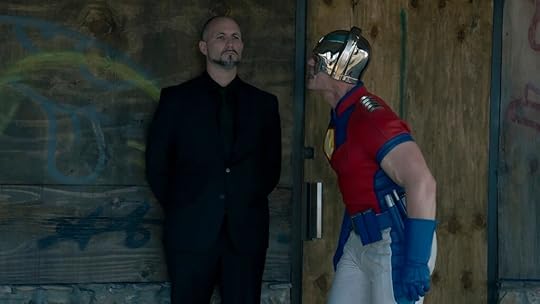 John Cena in “Peacemaker.” (HBO Max)What are the retcons?
John Cena in “Peacemaker.” (HBO Max)What are the retcons?The changes are slight and play slightly comical, but they get the job done. Most everything from Season 1 — which aired nearly three years ago, before Gunn and Peter Safran took the wheel of the DCU — was safe aside mentions of the Justice League and those big cameos in the finale.
To fix that the recap does some pretty obvious editing. In one moment Adebayo (Danielle Brooks) clearly is on a call asking for the Justice League to be sent in to help and a clever cut and dub has her asking for the Justice Gang — a small team that debuted in Gunn’s “Superman.” The Justice Gang consists of Green Lantern (Nathan Fillion), Mr. Terrific (Edi Gathegi) and Hawkgirl (Isabela Merced).
At the end of the Season 1 finale, Peacemaker stops Project Butterfly and comes out to see that the Justice League assembled after all the fighting is over. Superman (Henry Cavill), Aquaman (Jason Momoa), The Flash (Ezra Miller) and Wonder Woman (Gal Gadot) show up late and get yelled at by Peacemaker.
In the recap of Season 1, clever editing replaces the Justice League with silhouettes of the Justice Gang. Green Lantern, Mr. Terrific and Hawkgirl are all there and joined by two others — Superman (David Corenswet) and his cousin Supergirl (Milly Alcock).
“Peacemaker” Season 2 releases new episodes Thursdays at 9 p.m. ET/6 p.m. PT on HBO Max.
The post ‘Peacemaker’ Season 2 Retcons Explained: How the Show Swapped in the Justice Gang appeared first on TheWrap.
James Gunn Unpacks New ‘Peacemaker’ Dance Sequence and Why Season 2 Is Not Another Multiverse Story
Note: This story contains spoilers from “Peacemaker” Season 2, Episode 1.
After three years away, James Gunn knew big changes were coming for “Peacemaker” Season 2 and they started with a complete redo of its viral opening number.
The first season of the DCU series enjoyed some startling virality right out of the premiere gate with an opening dance routine set to Norwegian metal band Wig Wam’s “Do Ya Wanna Taste It.” The cast of the show went through a stilted, awkward, yet always charming number to the song on a soundstage while the credits rolled. It was a hit that sparked enough curiosity in those just seeing the opening to check out the show.
And then Gunn decided to change the entire thing for Season 2.

“I knew the dance had to change because we killed everybody in Season 1,” Gunn told TheWrap. “But I wasn’t sure whether I was going to change the song or keep the song the same and do a different dance. And after just listening to a lot of things, and just going walking through my imagination, I eventually hit upon ‘Oh Lord,’ which I thought was great. They have a great music video which has dancing in it, and I thought that was a good inspiration for Season 2.”
He continued: “[Foxy Shazam] are literally my favorite band. But I think that the lyrics are very much about what happens in Season 2. I think that in the same way ‘Do Ya Wanna Taste It’ really captured the flavor, both the light and the dark sides of Season 1, the same is true of ‘Oh Lord.’
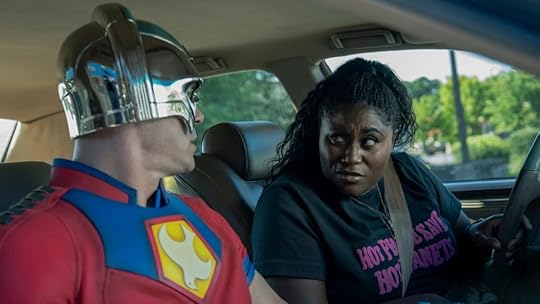 John Cena and Danielle Brooks in “Peacemaker.” (HBO Max)
John Cena and Danielle Brooks in “Peacemaker.” (HBO Max)The opening sequence is far from the only change coming in Season 2. The self-proclaimed 11th Street Kids — Peacemaker (John Cena), Harcourt (Jennifer Holland), Adebayo (Danielle Brooks), Adrian (Freddie Stroma) and Economos (Steve Agee) — are all picking up the pieces of their lives. Despite saving the world from the alien invasion dubbed Project Butterfly, their lives are in various states of disrepair at the start of Season 2.
Gunn has always enjoyed writing a character experience a new rock bottom. And while he told TheWrap that despite some of the major losses the 11th Street Kids experienced toward the end of Season 1 — Peacemaker killed his dad, Adebayo fell out with her mother Amanda Waller — there were some net positives for all but one character.
“Harcourt’s the worst by far. I think there are small gains for Peacemaker. I think he did something good — honestly, killing his dad is probably good for his life. He’s more self aware, he’s more vulnerable. He’s more in touch with his feelings. He’s better off than he was at the beginning of Season 1. Adebayo is better off too. She knows who she is and she has dreams, and she’s just her ever-loving, optimistic self. “
He added: “Harcourt is worse off. Her job was everything to her. It’s all she’s ever done. The only people that mattered to her were the soldiers that walked alongside her, and she’s lost that. So she is a freaking mess.”
Although Gunn thinks Peacemaker is better off after killing his racist dad, the character is struggling with the weight of it and wanting to be a legitimate hero. The knife is only twisted when he uses the dimensional portal into a pocket universe his dad discovered and finds a door to another universe where he, his (still living) brother, and (also still living) father all work together as a team of heroes that are celebrated the world over.
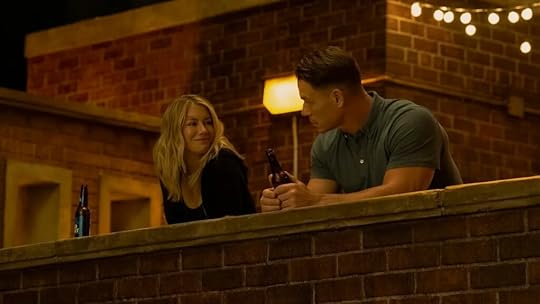 Jennifer Holland and John Cena in “Peacemaker.” (HBO Max)
Jennifer Holland and John Cena in “Peacemaker.” (HBO Max)Multiverse stories have been all the rage in the 2020s. The MCU is rocketing toward the conclusion of their Muliverse Saga and have already featured films with multiple Spider-Men and legacy X-Men recastings. Films like “Everything Everywhere All At Once” are telling Oscar-winning multiverse stories. The Season 2 premiere might end with Peacemaker fighting and killing an alternate version of himself, but Gunn assured that the season was not just looking to join the multiverse trend.
“It’s not really a multiverse,” Gunn explained. “It’s really one other dimension that is parallel to our own world — and it’s much more contemplative. I love ‘Deadpool & Wolverine’ and seeing all those billions of Deadpools and all the different permutations, and that’s a very fun thing. But that’s not what this is. This is more literary. It’s more like Philip Roth’s ‘The Counterlife’ than it is like ‘Deadpool & Wolverine.'”
He finished: “It’s about one other dimension, where Peacemaker is confronted with the possibility of things he never had. He’s staring the loss of things he never had straight in the face, and seeing a life that other people have. That is common to many of us, what he was robbed of in this universe and existentially trying to come to grips with that and what he’s going to do about it.”
“Peacemaker” Season 2 releases new episodes Thursdays at 9 p.m. ET/6 p.m. PT on HBO Max.
The post James Gunn Unpacks New ‘Peacemaker’ Dance Sequence and Why Season 2 Is Not Another Multiverse Story appeared first on TheWrap.
Katie Couric Dismisses Jillian Michaels’ Claim That Slavery Isn’t That Big a Deal: ‘She’s a Fitness Instructor, Not a Historian’ | Video
Katie Couric came in hot Thursday afternoon with some breaking news: former “The Biggest Loser” instructor Jillian Michaels is, indeed, not a historian.
The fitness pro-turned-conservative commentator caught some strays from the seasoned journalist during an Instagram Live she hosted with historian and professor Douglas Brinkley. While the engagement was primarily dedicated to President Donald Trump’s mandates against the Smithsonian and its National Museum of African American History and Culture, Couric asked Brinkley midway through the 26-minute discussion to weigh in on Michaels.
Couric called on him to “debunk … or at least contextualize” comments Michaels made on CNN last week downplaying the impact slavery has had on American society, arguing that only 2% of Americans owned slaves. “I think she is completely missing the point here, Doug,” Couric said.

“I don’t understand people who say things like that,” Brinkley said, echoing Couric’s frustration. “I mean, our whole history is about the Civil War and how Abraham Lincoln is the known as the Great Emancipator; you have the Lincoln Memorial there in Washington honoring him; his tomb in Illinois — Springfield — is sacred grounds. It is the crucible of the United States, the Civil War — 800,000 people killed. The ravages of slavery kind of exposed, we fought all of that. So one needs to study it.”
While Brinkley went on to place Michaels’ comments into the larger scope of Trump’s “whitewashing,” Couric later brought it back to the CNN dust-up.
“With all due respect, she is a fitness instructor and isn’t a historian,” Couric said of Michaels. “And I think it fails to acknowledge the institutional damage and the institutional prevalence of slavery writ large for the economy and for the people who enabled it and empowered it and embraced it.”
She added that speaking on such matters “without any kind of perspective or historical context, it’s a really dangerous thing.”
Watch the Instagram Live interview via Couric’s YouTube channel below:
While guesting Aug. 13 on CNN’s “NewsNight With Abby Phillip,” Michaels pushed back on the response to Trump’s effort to limit exhibitions on Black history and slavery and instead “celebrate American exceptionalism, remove divisive or partisan narratives and restore confidence in our shared cultural institutions” at the Smithsonian and elsewhere. She argued, “[Trump’s] not whitewashing slavery … You cannot tie imperialism and racism and slavery just to one race, which is pretty much what every single [museum] exhibit does.”
Michaels received immediate pushback from her fellow panelists, who reminded her that they were discussing the Smithsonian’s exhibits covering American history. “Jillian, I’m surprised that you’re trying to litigate who was the beneficiary of slavery,” Phillip told Michaels. “In the context of American history, what are you saying is incorrect by saying that it was white people oppressing black people?”
“Every single thing is like, ‘Oh, no, no, no, this is all because white people bad,’” Michaels responded. “That’s just not the truth.”
After the segment’s airing, viewers swiftly took to social media to blast Michaels for her comments — and criticize CNN for booking her in the first place.
The post Katie Couric Dismisses Jillian Michaels’ Claim That Slavery Isn’t That Big a Deal: ‘She’s a Fitness Instructor, Not a Historian’ | Video appeared first on TheWrap.
‘Peacemaker’ Season 1 Recap: What to Remember Before Season 2
From merciless blowhard to damaged but well-meaning himbo, John Cena’s Christopher Smith, aka Peacemaker, took a heck of a journey in the first season of his HBO Max show. First introduced in James Gunn’s 2021 movie “The Suicide Squad,” Peacemaker spun off into his own series, also helmed by Gunn, in January 2022.
That’s more than three years between seasons, so if you need a thorough recap of what happened in “Peacemaker” Season 1 before you watch Season 2, read on.
First, Is “The Suicide Squad” Canon?The continuity of the DCU is a bit confusing thanks to convoluted franchising amid major behind-the-scenes studio regime changes. “The Suicide Squad” and “Peacemaker” filmmaker James Gunn is now also the Co-CEO of DC Studios, at the helm of a new DC Universe, distinct from the DC Extended Universe that his first two DC projects existed in. So is the Peacemaker in “Peacemaker” the same guy from “The Suicide Squad?”

Yes, explicitly so in the first season. And going forward, though the DCU may retcon the exact details of who, what and where, the core of the character created by Gunn and Cena remains the same. So do the most important experiences he had in “The Suicide Squad.” It’s the starting point for “Peacemaker,” from which Chris Smith evolves into someone capable of love, friendship and loyalty.
What Happened in “The Suicide Squad?”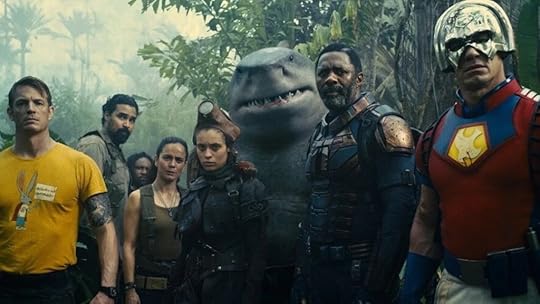 Warner Bros.
Warner Bros.In “The Suicide Squad,” we meet Christopher Smith, aka Peacemaker, as a prisoner of Belle Reve. Trained since childhood to be a stone-cold killer, Peacemaker gets recruited by Amanda Waller (Viola Davis) to join her Task Force X alongside other antiheroes, including Bloodsport (Idris Elba), Ratcatcher 2 (Daniela Melchior), Harley Quinn (Margot Robbie), and most importantly, Rick Flag (Joel Kinnaman). Waller sends them on a suicide mission to Corto Maltese, tied to something called Project Starfish.
Peacemaker’s whole thing is that he’s a hypermilitaristic, all-Americana psychopath who made a vow for peace, no matter how many men, women and children he has to kill to get it. Yikes! And indeed, after a few sequences that display how deadly he can be in action, Peacemaker ultimately becomes an antagonist to his own team in pursuit of his skewed version of justice.
Task Force X discovers that Project Starfish is, in fact, a gigantic space kaiju with mind control powers called Starro, which the American government is complicit in imprisoning, experimenting on and manipulating for political control. That’s a deal-breaker for Flag, who snatches up the evidence and promises to take it to the press. Peacemaker, on Waller’s orders, kills Flag, a soldier he admires, to prevent that from happening, and as Rick dies, he utters his final words: “Peacemaker, what a joke.” In the aftermath, Bloodsport shoots Peacemaker before he can execute Ratcatcher 2 just for being a witness, and Chris spends the rest of the movie under rubble until the post-credits scene reveals he somehow survived.
After Task Force X’s plan goes awry, Starro breaks out of containment and unleashes its wrath on the people of Corto Maltese. When the remaining squad teams up to help them, Waller orders them to stop, threatening to trigger the bombs implanted in their skulls if they continue. Fortunately, her staff at Bell Reve — including Harcourt (Jennifer Holland) and Economos (Steve Agee) take a stand against their merciless boss, knock her out and help Task Force X save the people of Corto Maltese. Peacemaker, notably, does not get the hero moment or character evolution that the rest of his team did. Yet.
If you want a more in-depth recap of the film, you’ll find that here.
Meet the Real Peacemaker John Cena in “Peacemaker” Season 1 (HBO Max)
John Cena in “Peacemaker” Season 1 (HBO Max)Flag’s death and his dying proclamation haunt Peacemaker throughout Season 1, serving as the traumatic blow that cleaves open his whole persona and the way he looks at the world.
We meet him at the start of Season 1 in the hospital, where he’s been recovering from the injuries he sustained during Project Starfish. After his doctor discharges him, he tries to sneak back home, a musty mess where he finds his dad never canceled his phone bill, and he’s got hundreds of missed calls — but they’re all from the same person, his wildcard fellow criminal-killing friend, Vigilante, aka Adrian Chase (Freddie Stroma).
Far from the self-assured, merciless killer we met in “The Suicide Squad,” the real Chris is a bit pathetic and hungry for affection. He’s so desperate for approval, he gets giddy when the waitress tells him “good choice,” and so desperate for love, his best friend is a bald eagle, Eagly. He’s also utterly oblivious to how much the people around him think he’s a racist villain. That’s a setup for comedy, but it’s also a testament to the fact that he hasn’t internalized his father’s bigotry as part of his identity. But we will get to the monster that is Auggie Smith.
From Project X to Project Butterfly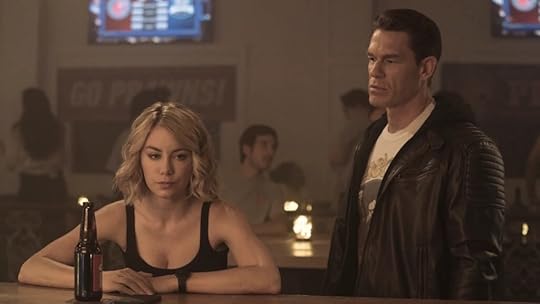 Jennifer Holland and John Cena in “Peacemaker” Season 1 (HBO Max)
Jennifer Holland and John Cena in “Peacemaker” Season 1 (HBO Max)Of course, Peacemaker only served four of his 30-year sentence, so ARGUS isn’t just going to let him go. When he gets home, a new team is waiting for him, guns drawn. There’s Harcourt (Jennifer Holland), his new handler, and John Economos, the tech and tactics guy, who were both on Waller’s team at Belle Reve in “The Suicide Squad.” Harcourt, in particular, despises Peacemaker. Then there’s Leota Adebayo (Danielle Brooks), the friendly newbie on the team, and the fearsome Clemson Murn (Chuckwudi Iwuji), who’s running the operation.
What’s the operation? Project Butterfly. And like Project Starfish before it, the name offers some hints about what kind of “monster” they’ll be facing. They want Peacemaker to be their gunman, killing people they call “Butterflies” — if he says no, he goes back to prison, or there’s always the bomb in his head. First up on his hitlist is a sitting U.S. senator … and his wife and kids.
During that mission, Peacemaker learns the hard way that the term Butterfly isn’t just a cute nickname. And he learns a bit about himself, too. The team has a sniper rifle locked in on the senator and his family, but despite his vow (peace, no matter how many men, women and children he has to kill to get it), Peacemaker can’t execute the mission and kill the kids, even after he sees clear evidence they’re not human.
Fortunately, Vigilante followed them to the mission site, and he’s got no problem taking the shots … at least the first three. Before he can take out Senator Goff, Judomaster (Nhut Le) shows up, and the pint-sized, Cheeto-guzzling snarky defender of the Butterflies kicks all their asses in no time.
Judomaster and Goff take and torture Peacemaker and Vigilante for information. Well, Vigilante is tortured, Goff just makes Peacemaker watch. Meanwhile, Economos captures Judomaster by T-boning his car and beating him with a tire iron, while the rest of the team breaks out Peacemaker and Vigilante. After Peacemaker shoots Goff in the head with a shotgun, a small insectoid with iridescent wings crawls out of his skull. Project Butterfly. Shortly after, a tactical screen reveals there are hundreds, maybe thousands of them embedded in people all over the world.
It’s a full-scale alien invasion, and as an off-the-books mission (any official investigation into the Butterflies gets shut down), this ragtag group is humanity’s last hope.
A Legacy of Violence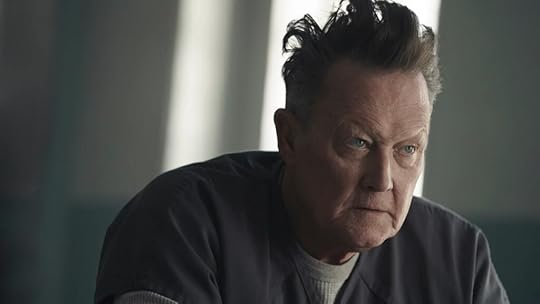 Robert Patrick in “Peacemaker” Season 1 (HBO Max)
Robert Patrick in “Peacemaker” Season 1 (HBO Max)Chris doesn’t just battle existential, potentially world-ending threats in “Peacemaker” Season 1, he’s also waging an internal war against the heinous, violent way of thinking that his father taught him. Played by the great Robert Patrick, Auggie Smith is horrendous. A hateful extremist, proud white supremacist, and relentlessly abusive father, Auggie is Chris’ root rot, poisoning his growth and prosperity from the ground up.
Auggie is profoundly cruel to his son, and seemingly has been his whole life. He doesn’t react at all when Chris tells him he was in the hospital for months. Auggie just snarls and calls his son “pathetic” for letting somebody shoot him. The only time we see him smile? When Chris tells him the horrific story of how Bloodsport’s father locked him in a crate with starving rats. He calls his son a “simp,” and ensures Chris knows he never thought about him once while he was in prison.
He trained his son to be a killer since childhood, something that sounds like super-spy Black Widow type stuff, but “Peacemaker” makes it so painfully pedestrian. In this case, it’s just a racist man putting a screwdriver in his son’s hand and making him kill someone. It’s a crass and cruel father, placing bets on his young sons, making them no-holds-barred fight in a dirt pit, and then holding it against Chris for the rest of his life when it goes tragically wrong.
Eventually, that’s what we learn happened to Chris when he was a child. Scrapping with his brother Keith at his father’s behest, Chris landed a blow that caused Keith to start seizing and foaming at the mouth before he died. He grows up blaming himself for his brother’s death, but his father blames him even more.
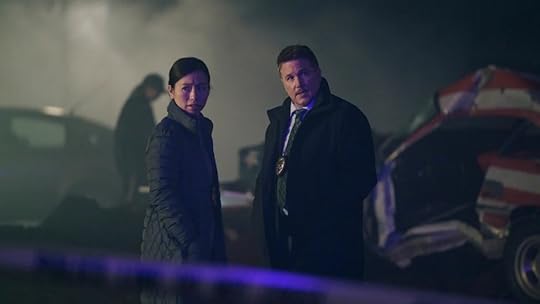 Annie Chang and Lochlyn Munro in “Peacemaker” Season 1 (HBO Max)
Annie Chang and Lochlyn Munro in “Peacemaker” Season 1 (HBO Max)And Auggie is not just a constant nightmare in Chris’ life, he also gets tangled up in Peacemaker’s business with ARGUS. After Chris has a one-night stand gone wrong, he winds up killing the metahuman girl after she attacks him. Economos whips up some guy-in-the-chair magic and swaps the evidence to implicate someone else – unfortunately, he chooses Peacemaker’s father, and Auggie gets locked up for the crime.
Even more unfortunate, Auggie is very much at home in prison, where there’s an eager group of violent white supremacists who idolize him as the White Dragon. Loosely inspired by a comic book character of the same name, this version of the White Dragon also integrates Peacemaker’s comic origin as the son of a Nazi. In fact, the White Dragon isn’t explained much in the show beyond being a white supremacist supervillain. Enough said.
Most unfortunate of all? Auggie’s not locked up nearly long enough. After he learns who framed him (In fact, Chris, the only one who can’t see who his father is, willingly tells him), Auggie promises to go straight to the cops, so Adebayo manipulates Vigilante into trying to kill him. That gives us some of Vigilante’s best moments when he gets himself thrown into prison, but his haphazard plan doesn’t work. Worse, once Auggie thinks his son tried to have him killed, he high-tails it to the detectives on the case, Sophie Song (Annie Chang) and Larry Fitzgibbon (L0chlyn Munro), who ensure his release and turn their attention to arresting Peacemaker.
The Quantum Unfolding Chamber The QUC in “Peacemaker” (HBO Max)
The QUC in “Peacemaker” (HBO Max)One more thing about Peacemaker’s dad to remember: he’s got a massive, extremely unexplained, physics-defying chamber in his house. This is what Gunn has dubbed the Quantum Unfolding Chamber (QUC), which in some way seems to allow Peacemaker and the White Dragon to create their high-tech super-suits (or helmets, in Peacemaker’s case). It doesn’t have a very big role to play in Season 2, but it’s confirmed that the QUC will have a significant role to play in the DCU and “Peacemaker” Season 2.
The 11th Street Kids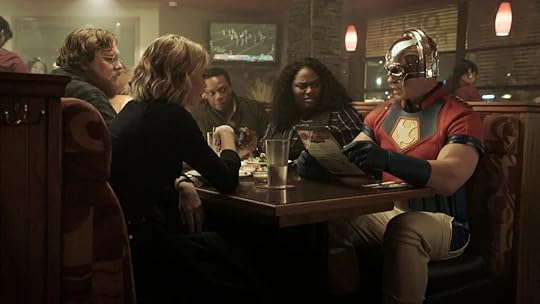 HBO Max
HBO MaxThis is a James Gunn production, so naturally, Peacemaker’s group of oddballs and outcasts was destined to form a found family. In fact, Gunn describes Season 1 as a love story about the friendship between Chris and Adeyabo, in particular, but the whole team sparks up a true-blue friendship after the most unlikely of circumstances – they defeat a killer gorilla together.
Their investigation leads them to the Glan Tai Bottling Company, and on the way to the mission, Chris and Economos finally find something to bond over: they’re both fans of Hanoi Rocks and jam out to the song “11th Street Kids.” Inside, the facility is full of Butterflies. With the help of Peacemaker’s X-ray helmet, they take care of the Butterflies with ease – until they meet Charlie, a Butterfly-inhabited silverback gorilla who protects the facility.
But the team has each other’s back through the whole fight, and Economos saves the day when he kills the gorilla with a chainsaw. After that, they’re a real team, and Harcourt consecrates that bond when she snaps a candid photo of them all celebrating their victory and sends it to their new group chat: the 11th Street Kids.
Adebayo’s Betrayal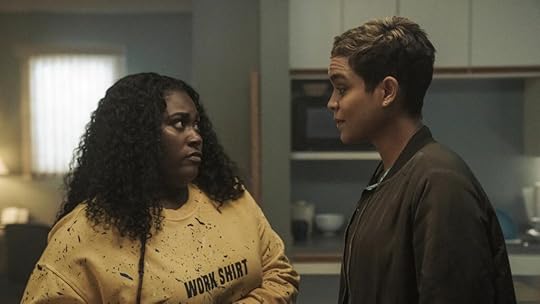 “Peacemaker” Season 1 (HBO Max)
“Peacemaker” Season 1 (HBO Max)Unbeknownst to the rest of the team, Leota Adebayo isn’t just a newbie, she’s the daughter of Amanda Waller, director of ARGUS. And Waller sent her in with a mission: to plant a diary on Peacemaker for all the violent chaos that has and will come from the Butterfly task force. As Harcourt (who is outraged that Adebayo would betray one of her own team members) says, they were “going to lone-shooter the guy.”
That means Chris and Adebayo’s friendship love story also includes some heartbreak. While sharing a celebratory drink after the Glan Tai Bottling mission, the two have a lovely moment of camaraderie, and he tells her he’s never had someone who had his back before. And that’s when she plants the journal.
Murn’s Big Secret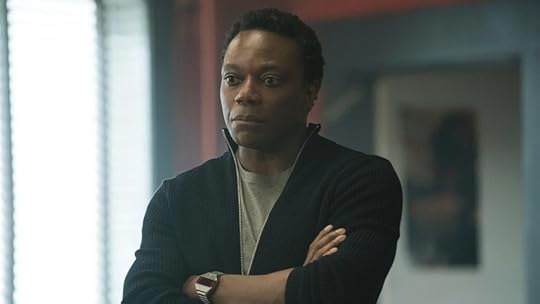 (HBO Max)
(HBO Max)Adebayo isn’t the only one on the team keeping secrets, as she learns when she puts on Peacemaker’s X-ray helmet and sees the Butterfly living in Murn’s head.
She panics at first, but soon realizes both Harcourt and Economos already know, and Murn is the sole dissenter of his kind, working with humanity to help stop the Butterfly invasion. He also feels tremendous guilt about taking a human body, but says he chose the worst person he could find in Clemson Murn. That means he also has insight into how to hit the Butterfly invasion where it counts. But before Murn and the team can launch their attack, Goff gets a win.
That’s because Peacemaker kept Goff alive, trapped in a jar at his place. He even got the Butterfly stoned and tried to have a yes/no conversation after Goff drew a peace sign on the inside of his jar. But when Detective Song and Detective Fitzgibbon come storming in to arrest Peacemaker, he and Vigilante have to escape through the roof and Goff breaks free from his jar when Vigilante falls out of a tree.
Goff wastes no time taking over the body of Detective Song, a violent and bloody process, and stages a mini invasion of the local police department. That means that Murn’s man on the inside is also compromised, and he knows the location of where they’re staying, so they’re exposed. Goff shows up in a hurry and summarily executes Murn, first shooting him dead without question and then crushing his insectoid body when he tries to fly out of Murn’s mouth. He dies in the palm of Harcourt’s hand.
Peacemaker vs. The White Dragon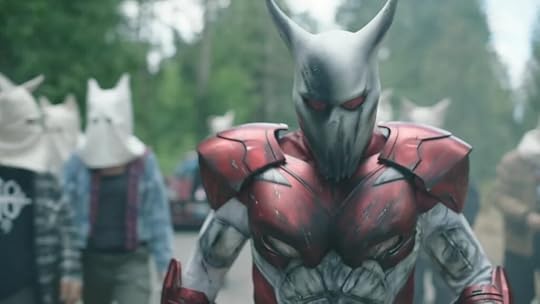 White Dragon in “Peacemaker” Season 1 (HBO Max)
White Dragon in “Peacemaker” Season 1 (HBO Max)While Harcourt and Adebayo are squaring off against Judomaster, Peacemaker, Vigilante, Economos and Eagly get locked into battle with Auggie, in his full White Dragon supersuit. Now that he’s out of prison, he’s made it his mission to kill his son, suiting up and rallying his troops to hunt him down.
The inevitable battle finally occurs in the penultimate episode of Season 1, when Peacemaker squares off against his supervillain Nazi father and his legion of white supremacists. It’s a harsh battle, and Eagly gets injured, but ultimately Peacemaker wins and finally does what he now realizes he should have done a long time ago. He kills his dad. Afterward, he starts to have visions of his father, hurling the same old insults.
Don’t Have a Cow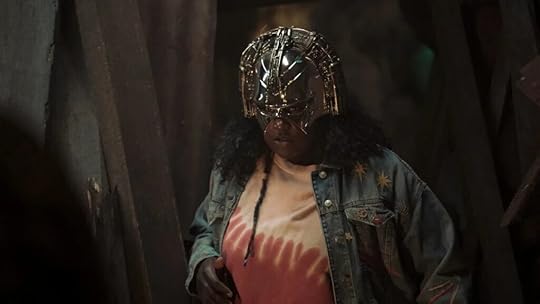 Danielle Brooks in “Peacemaker” Season 1 (HBO Max)
Danielle Brooks in “Peacemaker” Season 1 (HBO Max)After their respective fights, the gang meets up to execute the plan that can end the Butterfly invasion for good. The insectoid aliens feed on an amber, gooey substance. That’s what they’ve been shipping at that bottling company. And it all stems from a creature they call the Cow, a giant, pitiful, wormy thing that excretes their food source. And there’s only one Cow. If the team can kill the cow, they kill the invasion.
They make a plan to infiltrate the ranch where the cow is stored and use Peacemaker’s helmets to blow up the cow by sneaking in the Sonic Boom helmet and using a radio to issue the “Activate Sonic Boom” command. But Economos gets freaked while sneaking in to drop the bag and doesn’t take it low enough down the stairs before he leaves. That means they have to go back in, first Peacemaker, then Adebayo, who follows with the horribly designed Human Torpedo helmet as a last resort. Though she misses her first shot, Peacemaker activates it at just the right time, allowing them to take out the Cow in grotesque fashion.
More Than Anything in the WorldThat is a choice that Peacemaker doesn’t make lightly, because it’s not quite the cut-and-dry “hero saves the world” moment he might have hoped for. Before they kill the cow, Goff makes a final plea to Peacemaker, who the alien believes is a kindred spirit, willing to go to any extreme for the virtue they believe in. For Goff, that’s saving the Earth and humanity from the destruction that ravaged the Butterfly’s home planet. They see humans making the same selfish, short-sighted choices in spite of science, and decided to stage an alien invasion to save the world.
But Chris finally has his found family, a group of friends, and he puts the phrase “love you more than anything in the world” by choosing not to go with Goff’s plan, killing the cow instead. The team emerges triumphant from the barn, though Harcourt is critically injured, and Peacemaker finally gets to have his hero moment, walking away with his friend just in time to tell the latecoming Justice League to take a walk.
How Does Season 1 End?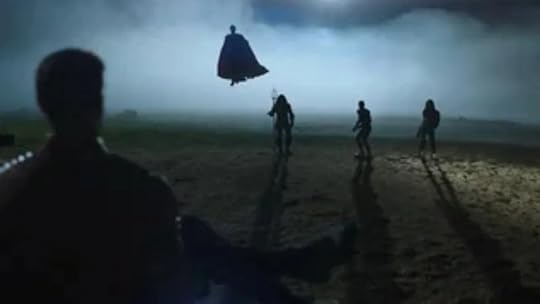 “Peacemaker” (Credit: HBO Max)
“Peacemaker” (Credit: HBO Max)“Peacemaker” wraps things up while setting the stage for Season 2 with a few key moments. Let’s dig into them.
The Justice LeagueYep, there was a Justice League cameo at the end of Season 1, including Ezra Miller’s Flash and Jason Momoa’s Aquaman (who was also a major running joke throughout the first season). So is that cannon in Season 2? Not really. Gunn has confirmed that bit of unwieldy phantom franchising will be retconned in Season 2 to exist within the DCU.
Adebayo Cleared Peacemaker’s Name and Outed Her MomJust like Chris ultimately chooses his new family over the fate of the world, Adebayo chooses them too in the end. To make things right for her betrayal, she goes to the press and confesses that she planted the journal in Peacemaker’s apartment at Waller’s behest. That’s not just a character beat for Adebayo, it also sets the stage for Rick Flag Sr. (Frank Grillo), who previously appeared in “Creature Commandos” and “Superman,” to take over ARGUS in Season 2.
Harcourt’s Warming UpAt the beginning of the Season, Harcourt detested Chris – in fact, she wouldn’t even call him that, insisting she call him Peacemaker. Harcourt sees him as a murderer, and as the season goes on, you realize she sees him as something even worse: a betrayer of his own team. That’s pretty much Harcourt’s No. 1 thing, you never ever betray your own team member. But that also means she has to be somewhat loyal to him once he’s on her team, and that gives him the chance to prove himself.
After nearly dying in the mission to kill the cow, Harcourt spends days in a coma and Peacemaker stays there the whole time. When she wakes up, they share a nice moment hand in hand.
A Bittersweet GoodbyeWe end Season 1 with Chris on his porch. He’s sitting with Eagly when Goff flies up to him, and Chris feeds Goff the last of the amber fluid Butterflies feed on — sweet because it’s an act of kindness, bitter because it’s Goff’s last meal. With the cow gone, the alien will die off after that.
Chris sips a beer with Eagly and Goff when a shadow falls across his face and the camera reveals he’s still seeing the specter of his father, Auggie, haunting him like a ghost and sitting right there on the porch with him.
“Peacemaker” is streaming on HBO Max.
The post ‘Peacemaker’ Season 1 Recap: What to Remember Before Season 2 appeared first on TheWrap.
Nicolas Cage in Talks to Lead ‘True Detective’ Season 5 Cast
“True Detective” might have found its next lead detective in Nicolas Cage.
Cage is in talks to lead the anthology series’ fifth season, according to media reports. Should Cage’s casting be confirmed, he would star as New York detective Henry Logan, who investigates the mystery at the center of Season 5. HBO declined to comment on this story.
After Season 4 focused on a cold case in the fictional town of Ennis, Alaska, Season 5 will turn its attention to Jamaica Bay in New York for a new mystery written by Season 4 showrunner Issa López, though the two seasons take place in the same universe, per López.
“The references are going to be more to Season 4,” López told TheWrap of Season 5, adding that supernatural elements will still be present. “It’s the same universe, and the magical realism is my brand, so it will be there.”

Should the deal become official, Cage would join the growing list of high-profile actors who have starred in the anthology series, which started out with Matthew McConaughey and Woody Harrelson for Season 1, before Colin Farrell, Rachel McAdams, Mahershala Ali and Jodie Foster joined for later seasons.
“True Detective” would mark Cage’s first on-screen TV role, and second TV role overall after leading Prime Video’s live-action Spider-Man series “Spider-Noir,” which has not yet been released.
Cage is best known for starring in “Face/Off,” “Next,” “Leaving Las Vegas,” “The Rock,” the “National Treasure” franchise, “Moonstruck,” “Arsenal,” “Snowden,” “Dark,” “The Unbearable Weight of Massive Talent,” “The Dream Scenario” and “Looking Glass.” He recently starred in Oz Perkins’ “Longlegs,” “The Surfer” and “Gunslingers.”
The post Nicolas Cage in Talks to Lead ‘True Detective’ Season 5 Cast appeared first on TheWrap.
Gavin Newsom Redistricting Campaign Raises $6.2 Million as Plan Moves to Special Election
Gov. Gavin Newsom raised over $6.2 million online from 200,000 donors just one week after he launched his state redistricting campaign ahead of a Nov. 4 special election.
The California governor announced he received more than 200,000 individual donations to the fight to redraw California’s congressional maps in response to Texas’ gerrymandered state maps, redrawn in favor of the Republicans under President Donald Trump directive.
“Over $6 million dollars and 200,000 donations in one week,” Newsom wrote in a post on X Thursday. “California and the nation are ready for this fight. Look out, Donald Trump. Your election rigging scheme is about to fall apart.”
That same afternoon, California Democrats approved a sweeping redistricting map to elect more lawmakers to the party. Newsom signed the bill and now it awaits the November vote. These new maps serve as a counter to the gerrymandered map that Republicans in Texas have also brought forward at Trump’s request. Texas’ changes will not be approved by registered voters in the state and will instead by implemented directly by lawmakers.
Newsom has branded the redistricting efforts as the “Election Rigging Response Act.” The new maps aim to create five new Democratic seats and four swing seats in the state. Nationwide Democrats see the remapping issue as the first battle of the 2026 midterm elections, which will determine control of Congress.
Under the proposed Nov. 4 ballot measure, the redrawn districts would be in effect for House races in 2026, 2028 and 2030 and would then revert to the independent redistricting commission to decide on what would be fair. Typically, redistricting occurs once a decade in line with the census.
Republicans currently control the House of Representatives, but if it changed hands to the Democrats, the party has expressed it would be a way to power check Trump throughout the second half of his term.
The post Gavin Newsom Redistricting Campaign Raises $6.2 Million as Plan Moves to Special Election appeared first on TheWrap.
Steve Pond's Blog



